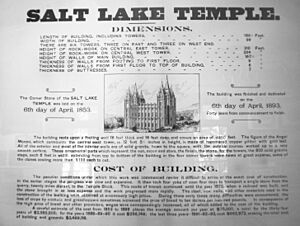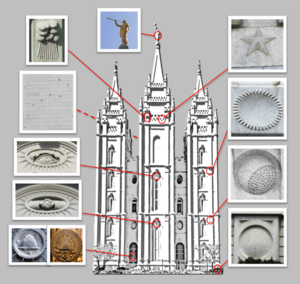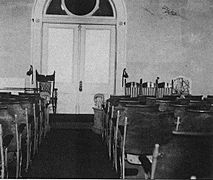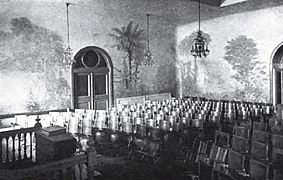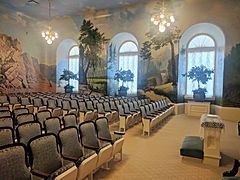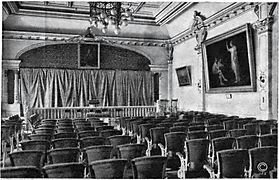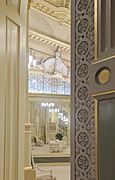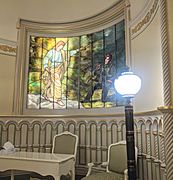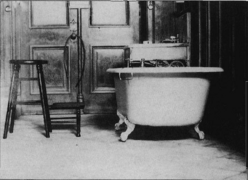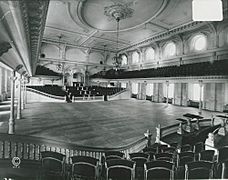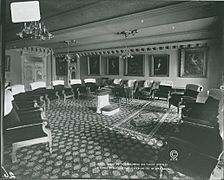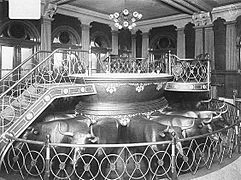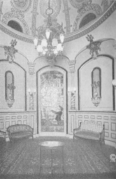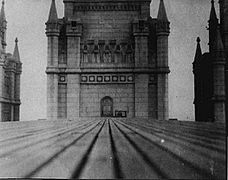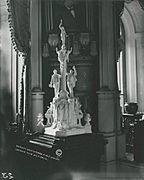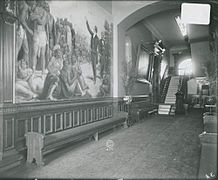Salt Lake Temple facts for kids
| Salt Lake Temple | ||||||||||||||||||||||||||||||||||||||||||||
|---|---|---|---|---|---|---|---|---|---|---|---|---|---|---|---|---|---|---|---|---|---|---|---|---|---|---|---|---|---|---|---|---|---|---|---|---|---|---|---|---|---|---|---|---|
Quick facts for kids Closed for Renovation |
||||||||||||||||||||||||||||||||||||||||||||
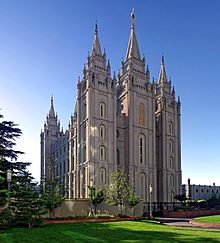 Salt Lake Temple is the centerpiece of the 10-acre (4.0 ha) Temple Square in Salt Lake City, Utah. |
||||||||||||||||||||||||||||||||||||||||||||
| Number | 4 | |||||||||||||||||||||||||||||||||||||||||||
| Dedicated | April 6, 1893 by Wilford Woodruff |
|||||||||||||||||||||||||||||||||||||||||||
| Site | 10 acres (4 hectares) | |||||||||||||||||||||||||||||||||||||||||||
| Floor area | 253,015 sq ft (23,506 m2) | |||||||||||||||||||||||||||||||||||||||||||
| Height | 222 ft (68 m) | |||||||||||||||||||||||||||||||||||||||||||
| Preceded by | Manti Utah Temple | |||||||||||||||||||||||||||||||||||||||||||
| Followed by | Laie Hawaii Temple | |||||||||||||||||||||||||||||||||||||||||||
| Official website: https://www.churchofjesuschrist.org/temples/details/salt-lake-temple • News & images | ||||||||||||||||||||||||||||||||||||||||||||
|
||||||||||||||||||||||||||||||||||||||||||||
The Salt Lake Temple is a special building for The Church of Jesus Christ of Latter-day Saints. It stands in Temple Square in Salt Lake City, Utah, United States. This temple is very large, covering about 253,015 square feet.
It was finished in 1893, taking 40 years to build! It was the sixth temple built by the church and the fourth since the Mormon pioneers moved from Nauvoo, Illinois, in 1846. In 2019, the church announced the temple would close for about four years for big updates to make it safer in earthquakes.
Contents
About the Salt Lake Temple
The Salt Lake Temple is the main building on the 10-acre Temple Square in Salt Lake City. Like other temples of the church, it is considered very sacred. Only members who follow certain rules can go inside. This means there are no public tours inside the temple. However, the grounds around the temple are open to everyone and are a popular place to visit.
The temple is also where the top leaders of the church, like the First Presidency and the Quorum of the Twelve Apostles, meet each week. It has special rooms just for them.
Some parts of the temple remind people of an ancient temple called Solomon's Temple in Jerusalem. For example, the temple faces Jerusalem. Also, a large font used for baptisms inside the temple rests on the backs of twelve oxen, just like a basin in Solomon's Temple.
Temple's Name
In 1999, the church decided on a way to name all its temples. Usually, temples in the United States and Canada are named after the city and state (like "Salt Lake City Utah Temple"). But for some reason, the Salt Lake Temple kept its original name.
Temple's Location
The temple is in downtown Salt Lake City, surrounded by mountains. A small stream, City Creek, flows nearby. A 15-foot-high wall surrounds the 10-acre temple site. This wall was one of the first permanent things built on Temple Square.
What Happens Inside the Temple
The temple is seen as God's house and is used for special ceremonies for church members. These ceremonies include:
- Endowment ceremony: This ceremony teaches about God's plan and helps members make promises to God. It uses several special rooms.
- Washing and anointing: This is a special blessing.
- Marriage sealing ceremonies: Couples can be married for eternity in the temple.
- Baptisms for the dead: Members can be baptized for their ancestors who have passed away.
Building the Temple
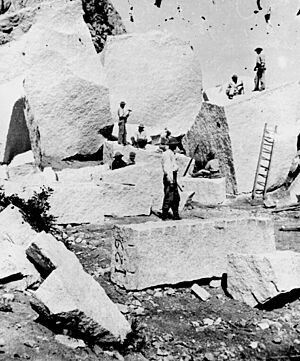
The spot for the temple was chosen by Brigham Young, the second president of the church, on July 28, 1847. This was just four days after he arrived in the Salt Lake Valley. The groundbreaking ceremony happened on April 6, 1853, when Young laid the first stone. The main architect was Truman O. Angell.
At first, sandstone was used for the foundation. During a time of trouble called the Utah War, the foundation was hidden to protect it. When work started again in 1858, many foundation stones were cracked. So, they were replaced with stronger stone.
The walls are made of a very hard rock called quartz monzonite, which looks like granite. This rock came from Little Cottonwood Canyon, about 20 miles away. At first, oxen pulled the heavy stones. But after the Transcontinental Railroad was finished in 1869, trains carried the rest of the stones much faster.
The very top stone, called the capstone, was placed on April 6, 1892. This stone holds the golden statue of the Angel Moroni. Wilford Woodruff, the church's fourth president, used an electric switch to put it in place. The Angel Moroni statue, which is 12.5 feet tall, was put on top later that same day.
Woodruff wanted the inside of the temple to be finished in one year. This would mean the temple could be dedicated exactly 40 years after it started. Thanks to John R. Winder, the inside was finished on time. Woodruff dedicated the temple on April 6, 1893.
Big Renovation (2019–2024)
In late 2019, the temple closed for a major update. This work will make the temple strong enough to survive a big earthquake. It is expected to take about four years. Other buildings on Temple Square will also be updated or rebuilt. The inside of the temple will be carefully preserved, and its old items will be protected. Even during the renovation, visitors can still come to Temple Square.
Temple Symbols
The Salt Lake Temple has many symbols carved into its walls. These symbols are important to the church's beliefs. Here are some of them:
- All-Seeing Eye: On the middle tower of each side, you can see an eye. This "All-Seeing Eye of God" reminds people that God sees everything.
- Angel Statue: A golden statue of the Angel Moroni stands on top of the temple. This angel represents the angel mentioned in the Bible (Revelation 14:6) who will announce the Second Coming of Christ. The statue is 12.5 feet tall. In 2020, a small earthquake broke the trumpet held by the statue.
- Beehive: You can see beehive symbols on the temple's doors and doorknobs. The beehive is also on the Utah state seal. It stands for hard work, order, and working together.
- Big Dipper: On the west side of the temple, you can see the Big Dipper constellation. This symbol shows how the priesthood (God's power given to people) can help guide people to heaven, just as the Big Dipper helps travelers find the North Star.
- Clasped Hands: Above each outside door, there are carvings of two hands shaking. This "hand clasp" represents the promises (covenants) made inside the temple and brotherly love.
- Clouds: On the east side of the temple, there are carvings of "clouds raining down." This symbolizes how God continues to give revelation (guidance) to people, like rain from heaven.
- Earths: At the bottom of the temple, there are round stones that look like the Earth. These "Earth Stones" can mean that the teachings of the church will spread all over the world.
- Spires: The temple has six tall spires. These represent the power of the priesthood. The three spires on the east side are a little taller than those on the west. The three taller spires represent the church's First Presidency, and the twelve smaller spires on them represent the Twelve Apostles.
- Sun, Moon, and Stars: Around the temple, there are carved stones showing the Sun, Moon, and stars. These represent different levels of glory or kingdoms in the afterlife: the sun for the highest (celestial), the moon for the next (terrestrial), and the stars for the lowest (telestial).
Inside the Temple
Many years ago, in 1912, the church decided to release a book called The House of the Lord with official photos of the temple's interior. This happened after someone took unauthorized pictures. Here are some of the rooms inside:
-
Council room for the First Presidency and Twelve Apostles
Temple Presidents
- Lorenzo Snow, 1893–1898
- Joseph F. Smith, 1898–1911
- Anthon H. Lund, 1911–1921
- George F. Richards, 1921–1938
- Stephen L. Chipman, 1938–1945
- Joseph Fielding Smith, 1945–1949
- Robert D. Young, 1949–1953
- ElRay L. Christiansen, 1953–1961
- Willard E. Smith, 1961–1964
- Howard S. McDonald, 1964–1968
- O. Leslie Stone, 1968–1972
- John K. Edmunds, 1972–1977
- A. Ray Curtis, 1977–1982
- Marion D. Hanks, 1982–1985
- Victor L. Brown, 1985–1987
- Edgar M. Denny, 1987–1990
- Spencer H. Osborn, 1990–1993
- George I. Cannon, 1993–1996
- Carlos E. Asay, 1996–1999
- Derrill H. Richards, 1999
- W. Eugene Hansen, 1999–2002
- L. Aldin Porter, 2002–2005
- M. Richard Walker, 2005–2008
- Sheldon F. Child, 2008–2011
- Oren Claron Alldredge Jr., 2011–2014
- Cecil O. Samuelson, 2014–2017
- B. Jackson Wixom, 2017–2019
Images for kids
See also
 In Spanish: Templo de Salt Lake City para niños
In Spanish: Templo de Salt Lake City para niños



